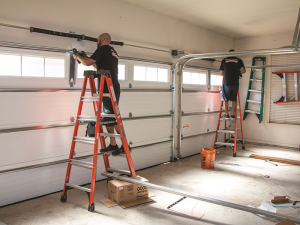A kitchen remodel is one of the most common home improvement projects. It involves updating the layout and design to reflect the homeowner’s needs, style, and lifestyle.
It’s important to keep in mind that the kitchen should appeal to future home buyers as well. Avoid making overly-custom elements that may only cater to a niche audience. Contact Tacoma Kitchen Remodel now!

When considering a kitchen layout, the options are nearly endless. Choosing your cabinets, tile, appliances and paint may be the most fun part of the process, but how well your space functions has everything to do with its layout. Kitchen layout ideas can vary from traditional to open-plan, but it’s important to consider how the space will be used before committing to a specific design.
The U-shaped kitchen layout is a popular choice for many home designs, providing storage on three sides and a functional work triangle for cooking. This layout can also include a kitchen island, which offers additional prep space and seating for entertaining guests.
This layout is ideal for narrow spaces and creates a clean line between the refrigerator, oven and sink. The drawback to this design is that it can feel claustrophobic with a single door opening in and out of the workspace. Creating more entrances into the space will help manage this issue.
For large spaces, a double island kitchen is a wonderful option that provides ample counter space and storage. You can even separate the islands to create distinct dining and entertainment areas within the larger room.
One-wall kitchens are often seen in apartment suites and smaller homes. The limited storage capacity can be a challenge, but it is possible to maximize efficiency with creative internal storage solutions like Le Mans corner units or pull-out shelves. A slim island or butcher block can provide additional counter space, while floor-to-ceiling cabinetry can offer plenty of storage for all of your appliances.
A G-shaped kitchen layout has four sides of cabinetry with the fourth side usually being a peninsula. This kitchen layout can make rooms feel spacious and increase surrounding storage space, but it can be difficult to access items stored in the corners of cabinets. Creating wider entryways into the kitchen and installing solutions like lazy susans in corner cabinets can help address this issue.
Cabinets
Cabinets are one of the biggest elements in a kitchen and have a significant impact on both style and function. Homeowners can choose from a wide range of premium brands that provide unlimited design options. Cabinets are usually made of wood, but can also be constructed out of metal or plastic. In addition, homeowners can add decorative hardware such as handles and knobs to complement their overall aesthetic and style choices. Under cabinet lighting and other features can also be added for both functional and visual purposes.
Choosing the right cabinets will greatly enhance your cooking experience, and if done correctly, will increase your home’s resale value when it comes time to sell. An experienced realtor can help you select timeless styles that will stand the test of time, and will be appealing to potential buyers.
The material from which your cabinets are built and the construction techniques used will determine the look, durability, and cost. Cabinets are often made of either solid wood or man-made materials such as particleboard, plywood or medium density fiberboard (MDF). Solid wood cabinets have a natural beauty and offer a luxurious impression, but are generally more expensive than their engineered counterparts.
The drawers in your cabinets will also differ in quality, with some using a dovetailed method of joining the box and the drawers together, while others will use screws or butt joints. It is recommended that you opt for a higher quality option such as dovetailed drawers to ensure maximum strength and longevity. Lastly, the finish that your cabinets are coated with will also affect their durability and appearance. Options include stain, painted, or glazed finishes. Choosing a durable, water-resistant coating is important in areas of the home that are often exposed to moisture.
Countertops
Countertops are a focal point in the kitchen, and the choice you make can affect how well your kitchen functions. New countertops are a significant investment, but one that can increase the resale value of your home and improve the overall look of your space.
When considering countertop options, consider your cooking style and desired aesthetic. For example, do you prefer a natural stone or a manmade material? Do you want a light and bright design or something with some warmth and character? Also, think about the color of your cabinets and whether or not you would like to match or contrast.
Quartz is an engineered countertop material that comes in a range of colors, from pale and neutral to deep and dramatic. It’s heat-resistant, durable and easy to maintain. Plus, it can be shaped to fit your kitchen. Granite is another popular option that looks beautiful and adds resale value to your home. It’s durable and resistant to scratches, burns and stains. It’s also available in a wide variety of patterns and hues to suit different design styles.
Tile countertops are a budget-friendly choice that’s easy to install and offers a range of colors, patterns and textures to complement your decor. It’s also heat-resistant, scratch-resistant and easy to clean, although grout lines can become dirty quickly if not kept clean.
Laminate countertops are experiencing a resurgence thanks to innovative designs that resemble wood, marble and even quartz at a fraction of the cost. You can even find laminates in retro ’50s boomerang shapes for a fun and functional mid-century look. For maximum versatility, mix-and-match your countertop materials. For instance, choose butcher block for the counter on which you roll out pastry and use as a cutting board, while opting for marble or solid surface for other areas that may get wet.
Appliances
A kitchen remodel is an excellent opportunity to upgrade your appliances. New, attractive, energy-efficient appliances not only improve the look of your kitchen but can also increase the resale value of your home and make meal prep a breeze.
Choosing the right appliances for your kitchen is an important part of your overall remodeling plan and can have a major impact on your budget. Appliances are one of the most costly items in any kitchen remodel, so it’s important to determine what your priorities and desired looks are before you start shopping. It’s a good idea to wait to buy your appliances until after you have your cabinet showroom design and layout, which will ensure that you don’t choose appliances that won’t work well with the final design.
The type and brand of appliances you purchase will affect your kitchen’s overall cost. More mainstream brands offer reliability and functionality at a more accessible price point, perfect for the average kitchen remodel. On the other hand, luxury brands like Sub-Zero and Wolf provide advanced technology and sleek design to transform your kitchen into a culinary haven.
Unique appliances can serve as conversation pieces in your kitchen and allow you to showcase your personal style. For example, a coffee bar or sous vide machine can help you create delicious beverages and dishes that reflect your culinary preferences. Additionally, smart appliances can help you keep track of food expiration dates, automate cooking tasks, and even monitor your home’s security. Incorporating these state-of-the-art features in your kitchen can be a great way to show off your technological expertise and future-proof your space for upcoming trends. Lighting is another area where costs can fluctuate depending on what type of fixtures and features you select. Basic LED recessed ceiling lights and undercabinet lighting are typically the least expensive options while high-end pendants, home automation controlled lighting, and custom designs will cost more.
Lighting
Lighting is a key component of the kitchen remodel. In addition to providing functional illumination, it can add a stylish flair and set the mood for your space.
Pendant lights can draw people into your kitchen with their dramatic impact and variety of styles. Forget dinky pendants over the island – go for large single fixtures or arrange multiple smaller designs to create an overhead focal point. Opt for translucent fixtures to hide the bulbs underneath and deliver a soft glow. Or try lantern kitchen lights, traditional and modern designs that surround bright bulbs with a metal framework to deliver a show-stopping statement above an island or dining table.
Recessed lighting is a must for kitchens, providing both general and task illumination. It is also important to incorporate dimmable lighting, which allows homeowners to adjust the brightness based on the time of day and activity in the room. It is important to balance cool and warm light, with cooler light used for workspaces and warmer light for dining areas to create a more inviting atmosphere.
As the kitchen becomes more of a living/gathering space for many homeowners, artwork is often displayed on the walls. Shedding light on this artwork can enhance its beauty, and recessed, adjustable fixtures can highlight paintings, framed photos and other decorative elements.
A common mistake is using only one type of lighting throughout the kitchen. This can result in shadows and unbalanced illumination, but using a mix of fixtures—from chandeliers to semi flush mounts—can help achieve a well-lit and balanced look. Other essential factors to consider include incorporating energy-efficient lighting and sustainable materials, which appeal to eco-conscious buyers and contribute to long-term cost savings.






